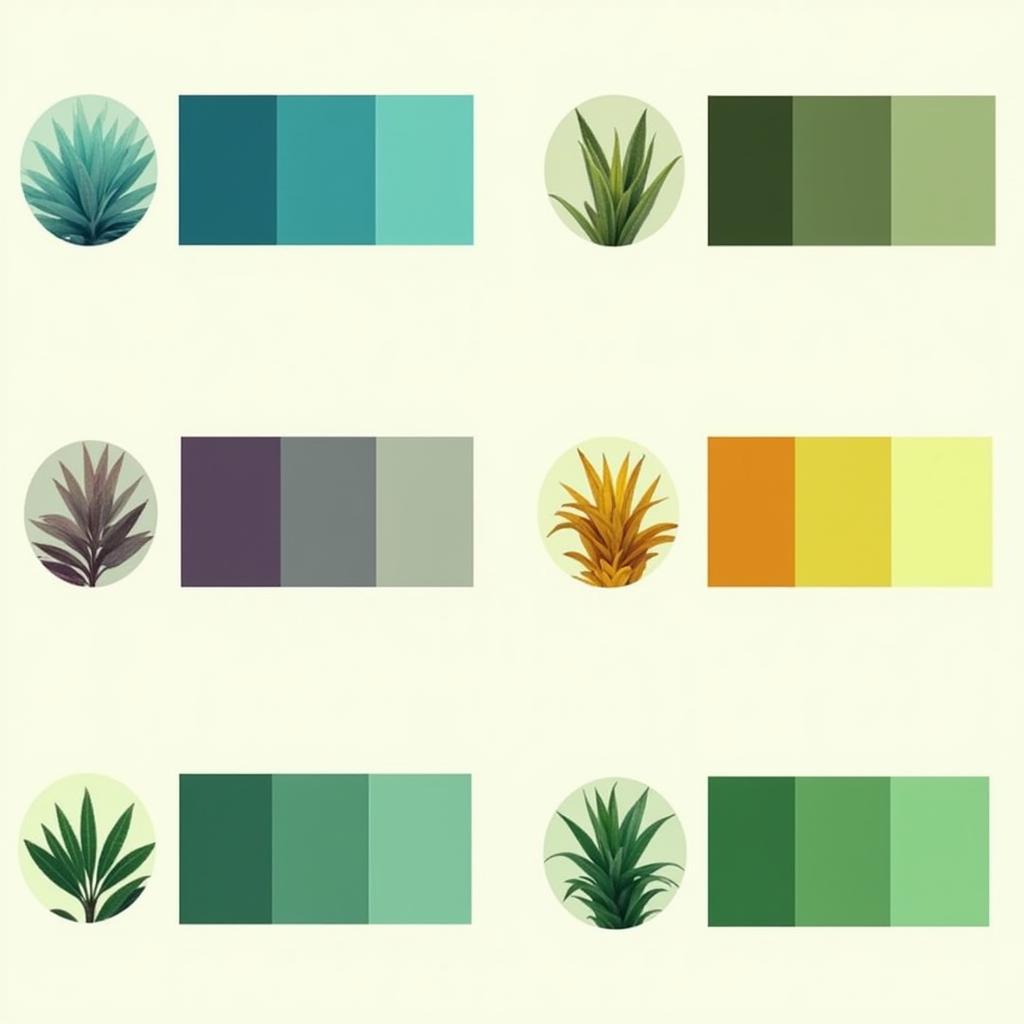Green: it’s the color of lush forests, rolling hills, and vibrant emeralds. But is green a warm or cool color? The answer, surprisingly, isn’t always straightforward. It depends on the specific shade of green and the colors it’s paired with. Let’s dive into the fascinating world of green and explore its place on the color spectrum.
Decoding the Warm and Cool Sides of Green
Understanding whether a green is warm or cool lies in its undertones. Think of it like mixing paint: a green with blue undertones will lean towards the cool side, evoking a sense of tranquility and calm. These cool greens are reminiscent of deep oceans and frosty winter landscapes. Conversely, greens with yellow undertones will feel warmer, radiating energy and vibrancy, like a sun-drenched meadow.
 Cool and Warm Greens
Cool and Warm Greens
Imagine standing in a forest filled with pine trees. The deep green of the needles, tinged with blue, evokes a sense of coolness and stillness. Now picture yourself in a field of spring grass. The yellowish-green hue feels lively and warm, full of life and energy. This subtle shift in undertone completely transforms the mood and feeling associated with the color.
If you’re wondering what color goes good with mustard yellow, cool greens often create a striking contrast.
How Undertones Influence Green
The undertones in green aren’t just about aesthetics; they play a crucial role in interior design and fashion. A cool green can make a room feel larger and more airy, while a warm green can create a cozy and inviting atmosphere. Knowing this, you can use green strategically to achieve the desired effect in any space.
Using Green in Your Home
Warm greens, like olive and chartreuse, work beautifully in kitchens and dining rooms, fostering a sense of warmth and togetherness. Cooler greens, like teal and emerald, are perfect for bedrooms and bathrooms, creating a calming and relaxing environment.
Consider the impact of green in your wardrobe as well. A cool emerald green dress can exude elegance and sophistication, while a warm lime green top can add a touch of playful energy to your outfit. Choosing the right shade of green can make all the difference in expressing your personal style.
Green in Nature: A Spectrum of Warm and Cool
Nature provides the perfect example of green’s versatility. From the cool, bluish-green of a pine forest to the warm, yellowish-green of a sunlit meadow, the natural world showcases the full spectrum of this fascinating color. Observing these natural variations can inspire your own use of green in design and everyday life.
Why Knowing the Temperature of Green Matters
Understanding whether a green is warm or cool is essential for creating harmonious color palettes. By carefully considering the undertones, you can ensure that your chosen greens complement other colors in your space or outfit. For instance, pairing a warm green with other warm colors like yellows and oranges can create a vibrant and energetic feel. Conversely, combining a cool green with blues and purples can result in a serene and calming ambiance. If you’re curious about what color goes with maroon shirt, certain shades of green can create a sophisticated and balanced look.
 Green Color Palettes
Green Color Palettes
John Smith, a renowned color consultant, shares his perspective: “Green’s versatility is what makes it so captivating. By understanding its warm and cool variations, you can unlock its full potential and create truly stunning spaces.”
Emily White, a leading interior designer, adds, “Green is a powerful tool for setting the mood of a room. Choosing the right shade can transform a space from sterile to inviting, or from chaotic to tranquil.”
Conclusion: Embracing the Versatility of Green
So, is green a warm or cool color? The answer lies in its undertones. By recognizing the subtle nuances of green, you can harness its power to create spaces and outfits that reflect your personal style and desired atmosphere. Whether you prefer the calming embrace of a cool emerald or the vibrant energy of a warm lime, the world of green offers endless possibilities. If you’re intrigued by the meaning of colors, you might be interested in learning what do colors on a mood ring mean? Or, perhaps you’re curious about what color is pea coat? For a deeper dive into the temperature of green, check out is green a cool or warm color.
FAQ
- What determines if a green is warm or cool? The undertones, primarily blue for cool greens and yellow for warm greens.
- How can I use warm greens in my home? Warm greens are ideal for kitchens, dining rooms, and living areas to create a welcoming and cozy atmosphere.
- What are some examples of cool greens? Teal, emerald, seafoam, and forest green are examples of cool greens.
- How can I use green in my wardrobe? Choose cool greens for a sophisticated look and warm greens for a more energetic vibe.
- What colors pair well with cool greens? Blues, purples, and other cool colors create a calming and harmonious palette with cool greens.
- What colors complement warm greens? Yellows, oranges, and other warm colors create a vibrant and energetic scheme with warm greens.
- What are some common examples of green in nature? Grass, leaves, trees, and moss all exhibit various shades of green in nature.
Need help choosing the perfect green for your project? Contact us!
Phone: 0373298888
Email: [email protected]
Address: 86 Cầu Giấy, Hà Nội.
Our customer service team is available 24/7.